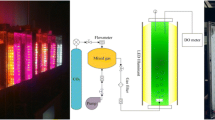Abstract
This study on dynamic changes of culture color, astaxanthin and chlorophylls, inorganic N including N−NO −3 , N−NO −2 and N−NH +4 in batch culture ofHaematococcus pluvialis exposed to different additive nitrate concentration showed (1) ast/chl ratio was over 0.8 for brown and red algae, but was usually less than 0.5 for green and yellow algae; (2) N−NO −3 , in general, was unstable and decreased, except for a small unexpected increase in nitrate enriched treatment groups; (3) measurable amounts of N−NO −2 , and N−NH +4 were observed respectively with three change modes although no external nitrite and ammonia were added into the culture; (4) a non-linear correlation between ast/chl ratio (or color) changes and the levels of N−NO −3 , N−NO −2 , N−NH +4 inH. pluvialis culture; (5) up and down variation of the ast/chl ratio occurred simultaneously with a perceptible color change from yellow to brown (or red) when N−NO −3 , N−NO −2 and N−NH +4 fluctuated around 30, 5, 5, μmol/L respectively; (6) existence of three dynamic modes of N−NO −3 , N−NO −2 and N−NH +4 changes, obviously associated with initial external nitrate; (7) the key level of total inorganic N concentration regulating the above physiological changes during indoor cultivation was about 50 μmol/L; and (8) 0.5–10 mmol/L of nitrate was theoretically conducive to cell growth in batch culture.
Similar content being viewed by others
References
Arnon, D. I., 1949, Copper enzymes in isolated chloroplasts; polyphenol oxidase inBeta vulgaris.Plant Physiology 24:1–15.
Borowitzka, M., Huisman, J. M., Osboen, A., 1991. Culture of the astaxanthin-producing green algaHaematococcus pluvialis I. Effects of nutrients on growth and cell type.J. Appl. Physiol. 3:295–304.
Bossiba, S., Vonshak, A., 1991. Astaxanthin accumulation in the green algaHaematococcus pluvialis.Plant cell physiol. 32(7):1077–1082.
Bubrick, P., 1991. Production of astaxanthin fromHaematococcus.Bioresource Technology 38:237–239
Chaumont, D., Thepenier, C., 1995. Carotenoid content in growing cells ofHaematococcus pluvialis during a sunlight cycle.J. Appl. Phycol. 7:529–537.
Cramer, M., Myers, J., 1948. Nitrate reduction and assimilation inChlorella.J. Gen. Physiol. 32: 93–102.
Davies, B. H., 1976. Carotenoids. In Goodwin TW (eds.) The biochemistry of carotenoids. 38–165.
Donkin, P., 1976. Ketocarotenoid biosynthesis byHaematococcus lacustris.Phytochemistry 15:711–715.
Droop, M. R., 1954. Conditions governing haematochrome formation inHaematococcus pluvialis Flotow.Arch. Mikrobiol. 20:391–397.
Gao, F. M., Zhang, S. H., Wang, X. Y. et al., 1980. Determination of ammonia in seawater by hyppobromate oxidation method.Transactions of Oceanology and Limnology 4:41–46.
Grung, M., Frances, M. L. D., Borowitzka, M. A. et al., 1992. Algal carotenoids 51. secondary carotenoids 2.Haematococcus pluvialis aplanospores as a source of (3s, 3s)-astaxanthin esters.J. Appl. Phycol. 4:165–171.
Hagen, C., Braune, W., Bjorn, L. O., 1994. Functional aspects of secondary carotenoids inHaematococcus lacustris (Volvocales). III. Action as a sunshade.J. Physcol. 30:241–248.
Harker, M., Tsavalos, A. J., Young, A. J., 1995. Use of response surface methodology to optimise carotenogenesis in the microalga,Haematococcus pluvialis.J. Appl. Phycol. 7:399–406.
Jin, C. Y., Song, L. R., Liu, Y. D., Gan, X. N., 1996. The nutrient requirement of a green algaHaematococus pluvialis sp. NB748.Act Hydrobiol. Sinca 20(3):293–297.
Kabayashi, M., Kakizono, T., Nagai, S., 1993. Enhanced carotenoid biosynthesis by oxidative stress in acetate-induced cyst cells of a green unicellular alga,Haematococcus pluvialis.Appl. Environ. Microbiol. 59:867–873.
Lee, Y. K., Ding, S. Y., 1994. Cell cycle and accumulation of astaxanthin inHaematococcus lacustris (Chlorophyta).J. Phycol. 30:445–449.
Liu, J. G., Zhang, J. P., 2000a. Photosynthetic and respiration rate ofHaematococcus pluvialis.Ocean. et Limnol. Sinica 31(5):390–395.
Liu, J. G., Yin, M. Y., Zhang, J. P. et al., 2000b. Cell cycle ofHaematococcus plavialis.Ocean. et Limnol. Sinica 31(2):145–150.
Lu, F., Vonshak, A., Gabbay, R. et al., 1995. The biosynthetic pathway of astaxanthin in a green algaHaematococcus pluvialis as indicated by inhibition with diphenylamine.Plant Cell Physiol. 36(8):1519–1524.
Pratt, R., Fong, J., 1940. Studies onChlorella vulgaris. III. Growth ofChlorella and changes in the hydrogen-ion and ammonium-ion concentration in solutions containing nitrate and ammonium nitrogen.Am. J. Botany 27:735–743.
Pringshein, E. G., 1966. Nutritional requirement ofHaematococcus pluvialis and related species.J. Phycol. 2:1–7.
Proctor, V. W., 1957. Preferential assimilation of nitrate ion byHaematococcus pluvialis.Am. J. Botany 44: 141–143.
Shi, Z. L., Dai, G. S., Wang, H., Huang, Y. F. et al., 1980. Determination of nitrate in seawater by cadmium-copper reduction method.J. of Shandong College of Oceanology 10(3):53–63.
Sommer, T. R., Potts, W. T., Morrissy, N. M., 1991. Utilization of microalgal astaxanthin by rainbow trout (Oncorhynchus mykiss).Aquaculture 94:79–88.
Stross, R. G., 1963. Nitate preference inHaematococcus as controlled by strain, age of inoculum, and pH of the medium.Canadian J. Microbiology 9:33–40.
Tan, S., Francis, X., Cunningham, J. et al., 1995. Cytochrome floss in astaxanthin-accumulating red cells ofHaematococcus pluvialis (Chlorophyteae): comparison of photosynthetic activity, phytosynthetic enzymes, and thylakoid membrane polypeptides in red and green cells.J. Phycol. 31:897–905.
Yong, Y. Y. R., Lee, Y. K., 1991. Do carotenoids play a photoprotective role in the cytoplasm ofHaematococcus lacustris (Chlorophyta)?Phycolohia. 30(3):257–261.
Zoltnik, I., Sokenik, A., Dubensky, Z., 1993. Physiological and photosynthetic changes during the formation of red aplanospores in ChlorophyteHaematococcus pluvialis.J. Phycol. 29(4):463–469.
Author information
Authors and Affiliations
Additional information
Contribution No. 4139 from Institute of Oceanology, Chinese Academy of Sciences.
Projects 39500114, 39970575, A/2786-1 and 9565 supported by NSFC, IFS (International Foundation for Sciences) and Sci-Tech Commission of Shandong Province respectively.
Rights and permissions
About this article
Cite this article
Jian-guo, L., Ming-yan, Y., Jing-pu, Z. et al. Dynamic changes of inorganic nitrogen and astaxanthin accumulation inHaematococcus pluvialis . Chin. J. Ocean. Limnol. 20, 358–364 (2002). https://doi.org/10.1007/BF02847927
Received:
Accepted:
Issue Date:
DOI: https://doi.org/10.1007/BF02847927




